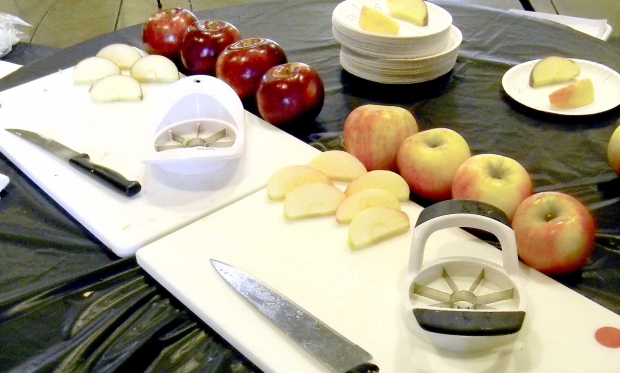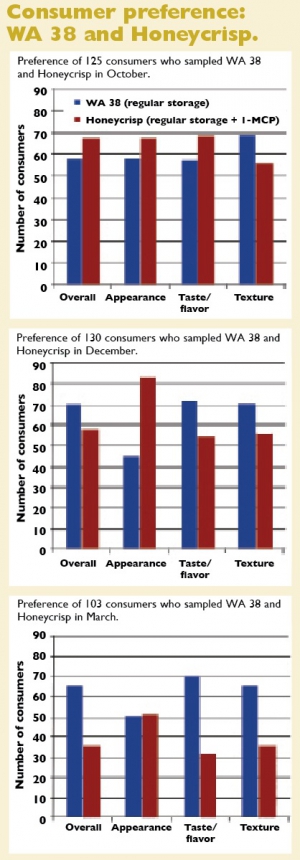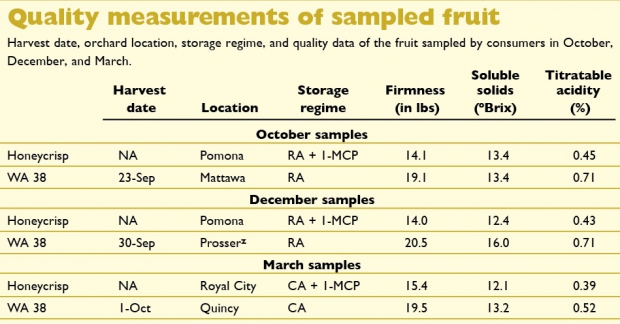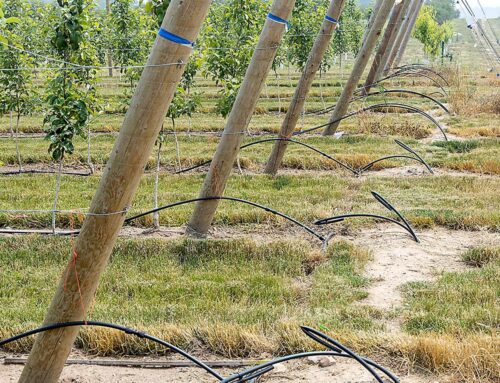
Consumers were asked to rate WA 38 and Honeycrisp apples in October, December and March. (Courtesy Washington State University)
The most recent release of the Washington State University apple breeding program, WA 38 is known for excellent texture and consistent flavor. A cross between Enterprise and Honeycrisp, WA 38 has created a lot of interest amongst Washington growers.
However, success of the variety in the marketplace will in large part be determined by consumer acceptance.
WSU’s apple breeder Dr. Kate Evans, food scientist Dr. Carolyn Ross, and the Washington Tree Fruit Research Commission’s postharvest scientist Dr. Ines Hanrahan tested consumer reactions to WA 38 and Honeycrisp at River Park Square Shopping Mall in Spokane, Washington. Direct pair-wise comparisons with Honeycrisp were chosen because Honeycrisp has been the top-selling apple cultivar based on returns to the grower and general consumer buzz.

(Source: Kate Evans, Washington State University)
Evaluations to gauge consumer preferences as the fruit came out of storage took place on three different dates: October 26, 2013; December 14, 2013; and March 15, 2014. Hanrahan sourced commercial-quality Honeycrisp for all three tests and chose fruit from the most commercially typical storage regime, which included application of MCP (1-methylcyclopropene).
Fruit of WA 38 was sampled from the breeding program’s Phase 3 grower sites at Mattawa, Quincy, and Prosser, Washington. Common fruit quality measurements were performed for all samples (see table “Quality measurements of sampled fruit”).
Consumers ranging from 18 to more than 70 years of age and with diverse ethnic backgrounds were recruited using poster advertising at the shopping mall.
Each consumer was given a slice of WA 38 and a slice of Honeycrisp and asked to rate which they preferred for appearance, taste/flavor, texture, and which they preferred overall. Whole apples were also available to help consumers rate appearance.
There was little difference in consumer preference between the two samples in October (none of the differences were statistically significant, see “Consumer preference: WA 38 and Honeycrisp”). Honeycrisp was slightly preferred overall and for taste/flavor and appearance. However, WA 38 was slightly preferred for texture.
In December, the appearance of Honeycrisp was significantly preferred to that of WA 38. However, WA 38 was slightly preferred overall and for taste/flavor and texture.
By March, there was no difference in consumer preference for the appearance of the fruit. However, the WA 38 was significantly preferred to the Honeycrisp for taste/flavor, texture, and for overall acceptance.
WA 38 samples from Prosser and Quincy had hail marks, which may account for differences in appearance ratings.
These tests confirm the consistency of the quality of WA 38 through storage. While the texture was rated similarly on all three dates, the preference for WA 38’s flavor improved over time from 58 consumers in October to more than 70 consumers in December and March.
For more information, check the website: www.tfrec.wsu.edu/pages/breed/WA38. •

RA: Regular atmosphere storage CA: Controlled atmosphere storage SOURCE: Kate Evans, WSU
1-MCP: 1-methylcyclopropene Z: Fruit from 2-year-old grafts (Source: Kate Evans, Washington State University)






Since many consumers could be highly influenced by the extreme beautiful red appearance of the W-38, It would be interesting to see if the results would vary if the samples were presented without the skin .This, I believe would a more fair and accurate test.